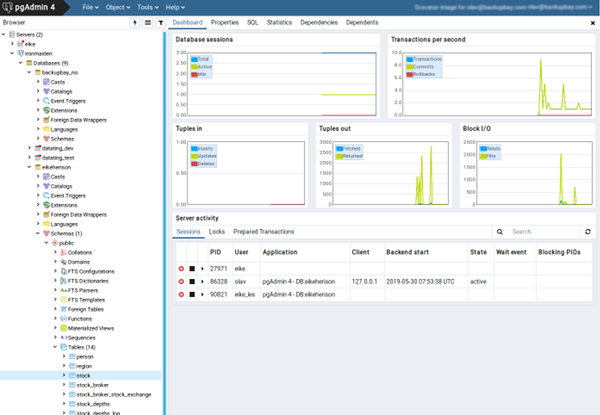This guide will help you install pgAdmin4 on your FreeBSD machine. What is pgAdmin? It is a free open source graphical management tool for PostgreSQL and derivative relational databases such as EnterpriseDB's EDB Advanced Server. It has a powerful query tool with colour syntax highlighting and graphical query plan display. For people that is not familiar with the Linux shell and the psql client, pgAdmin4 is an excellent tool for interacting with PostgreSQL.
(Screenshot of pgAdmin4)
FreeBSD Setup
Update ports
$ sudo portsnap fetch && portsnap extract
Install necessary packages (you can omit BATCH if you want to configure installations)
$ sudo make -C /usr/ports/lang/python36 install clean BATCH=yes
$ sudo make -C /usr/ports/devel/py-setuptools install clean FLAVOR=py36 BATCH=yes
$ sudo make -C /usr/ports/devel/py-virtualenv install clean FLAVOR=py36 BATCH=yes
$ sudo make -C /usr/ports/databases/py-sqlite3 install clean FLAVOR=py36 BATCH=yes
$ sudo make -C /usr/ports/databases/py-psycopg2 install clean FLAVOR=py36 BATCH=yes
$ sudo make -C /usr/ports/www/uwsgi install clean BATCH=yes
We use Python 3.6 as that is currently working with pgAdmin4 version 4.6.
Setup Python Environment
Create pgadmin app folder and data folder
$ sudo mkdir -p /opt/pgadmin/data
Create virtual python environment
$ sudo virtualenv --python=/usr/local/bin/python3.6 /opt/pgadmin/pgadm_env
Activate virtual env (make sure you are using bash, not sh)
$ source /opt/pgadmin/pgadm_env/bin/activate
Install and configure pgAdmin4
Check the latest release of pgAdmin4 here https://ftp.postgresql.org/pub/pgadmin/pgadmin4/
(pgadm_env)$ sudo pip install https://ftp.postgresql.org/pub/pgadmin/pgadmin4/v4.6/pip/pgadmin4-4.6-py2.py3-none-any.whl
We also need a local uwsgi binary
(pgadm_env)$ sudo pip install uwsgi
Create local pgadmin config file
$ sudo vim /opt/pgadmin/pgadm_env/lib/python3.6/site-packages/pgadmin4/config_local.py
Add following content to config_local.py
import os
DATA_DIR = os.path.realpath(os.path.expanduser(u'/opt/pgadmin/data'))
LOG_FILE = os.path.join(DATA_DIR, 'pgadmin4.log')
SQLITE_PATH = os.path.join(DATA_DIR, 'pgadmin4.db')
SESSION_DB_PATH = os.path.join(DATA_DIR, 'sessions')
STORAGE_DIR = os.path.join(DATA_DIR, 'storage')
Create PGAdmin superuser
(pgadm_env)$ sudo python /opt/pgadmin/pgadm_env/lib/python3.6/site-packages/pgadmin4/setup.py
NOTE: Configuring authentication for SERVER mode.
Enter the email address and password to use for the initial pgAdmin user account:
Email address: myemail@example.org
Password:
Retype password:
pgAdmin 4 - Application Initialisation
======================================
Create pgadmin user
$ sudo pw useradd pgadmin
Make user pgadmin the owner of the pgadmin installation
$ sudo chown -R pgadmin:pgadmin /opt/pgadmin
Configure UWSGI
This is the most annoying and probably hardest part. Hopefully this guide will help you through this.
First we want to use UWSGI Emperor mode, it makes it possible for us to to host multiple python applications through UWSGI. Even with different python version.
Create Vassals folder for UWSGI
$ sudo mkdir -p /usr/local/etc/uwsgi/vassals
Create pgadmin4.ini
$ sudo vim /usr/local/etc/uwsgi/vassals/pgadmin4.ini
[uwsgi]
uid = pgadmin
gid = pgadmin
socket = /tmp/pgadmin4.sock
chmod-socket = 666
logto = /var/log/uwsgi.log
chdir = /opt/pgadmin/pgadm_env/lib/python3.6/site-packages/pgadmin4
wsgi-file = pgAdmin4.wsgi
virtualenv = /opt/pgadmin/pgadm_env
unprivileged-binary-patch = /opt/pgadmin/pgadm_env/bin/uwsgi
threads = 10
Edit /etc/rc.conf
uwsgi_enable="YES"
uwsgi_flags="--emperor /usr/local/etc/uwsgi/vassals"
Now you can start UWSGI
$ sudo service uwsgi start
You still need to configure Nginx though
Configure Nginx
Create a new virtual host file for nginx that looks like tihs
upstream pgadmin_upstream {
server unix:/tmp/pgadmin4.sock;
}
server {
listen 80;
server_name pgadmin.example.org;
access_log off;
error_log off;
## redirect http to https ##
return 301 https://$server_name$request_uri;
}
# HTTPS server
server {
listen 443 ssl http2;
server_name pgadmin.example.org;
ssl_certificate /path/to/my/ssl/server.crt;
ssl_certificate_key /path/to/my/ssl//server.key;
ssl_session_timeout 5m;
error_page 500 502 503 504 /50x.html;
# Only allow local network
allow 192.168.1.0/24;
deny all;
ssl_protocols TLSv1 TLSv1.1 TLSv1.2;
ssl_ciphers EECDH AES128:RSA AES128:EECDH AES256:RSA AES256:EECDH 3DES:RSA 3DES:EECDH RC4:RSA RC4:!MD5;
ssl_prefer_server_ciphers on;
location / {
uwsgi_pass pgadmin_upstream;
include uwsgi_params;
uwsgi_modifier1 30;
}
}

